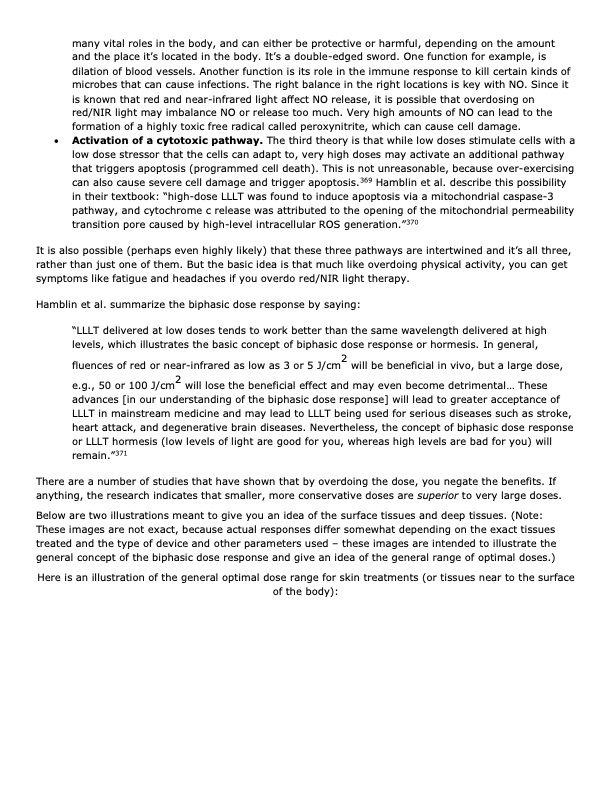
PDF Publication Title:
Text from PDF Page: 009
many vital roles in the body, and can either be protective or harmful, depending on the amount and the place it’s located in the body. It’s a double-edged sword. One function for example, is dilation of blood vessels. Another function is its role in the immune response to kill certain kinds of microbes that can cause infections. The right balance in the right locations is key with NO. Since it is known that red and near-infrared light affect NO release, it is possible that overdosing on red/NIR light may imbalance NO or release too much. Very high amounts of NO can lead to the formation of a highly toxic free radical called peroxynitrite, which can cause cell damage. • Activation of a cytotoxic pathway. The third theory is that while low doses stimulate cells with a low dose stressor that the cells can adapt to, very high doses may activate an additional pathway that triggers apoptosis (programmed cell death). This is not unreasonable, because over-exercising can also cause severe cell damage and trigger apoptosis.369 Hamblin et al. describe this possibility in their textbook: “high-dose LLLT was found to induce apoptosis via a mitochondrial caspase-3 pathway, and cytochrome c release was attributed to the opening of the mitochondrial permeability transition pore caused by high-level intracellular ROS generation.”370 It is also possible (perhaps even highly likely) that these three pathways are intertwined and it’s all three, rather than just one of them. But the basic idea is that much like overdoing physical activity, you can get symptoms like fatigue and headaches if you overdo red/NIR light therapy. Hamblin et al. summarize the biphasic dose response by saying: “LLLT delivered at low doses tends to work better than the same wavelength delivered at high levels, which illustrates the basic concept of biphasic dose response or hormesis. In general, fluences of red or near-infrared as low as 3 or 5 J/cm2 will be beneficial in vivo, but a large dose, e.g., 50 or 100 J/cm2 will lose the beneficial effect and may even become detrimental... These advances [in our understanding of the biphasic dose response] will lead to greater acceptance of LLLT in mainstream medicine and may lead to LLLT being used for serious diseases such as stroke, heart attack, and degenerative brain diseases. Nevertheless, the concept of biphasic dose response or LLLT hormesis (low levels of light are good for you, whereas high levels are bad for you) will remain.”371 There are a number of studies that have shown that by overdoing the dose, you negate the benefits. If anything, the research indicates that smaller, more conservative doses are superior to very large doses. Below are two illustrations meant to give you an idea of the surface tissues and deep tissues. (Note: These images are not exact, because actual responses differ somewhat depending on the exact tissues treated and the type of device and other parameters used – these images are intended to illustrate the general concept of the biphasic dose response and give an idea of the general range of optimal doses.) Here is an illustration of the general optimal dose range for skin treatments (or tissues near to the surface of the body):PDF Image | Red Light Therapy Ultimate Guide

PDF Search Title:
Red Light Therapy Ultimate GuideOriginal File Name Searched:
The-Ultimate-Guide-to-Red-Light-Therapy-Ultimate-Guide-To-Dosing.pdfDIY PDF Search: Google It | Yahoo | Bing
Cruise Ship Reviews | Luxury Resort | Jet | Yacht | and Travel Tech More Info
Cruising Review Topics and Articles More Info
Software based on Filemaker for the travel industry More Info
The Burgenstock Resort: Reviews on CruisingReview website... More Info
Resort Reviews: World Class resorts... More Info
The Riffelalp Resort: Reviews on CruisingReview website... More Info
| CONTACT TEL: 608-238-6001 Email: greg@cruisingreview.com | RSS | AMP |